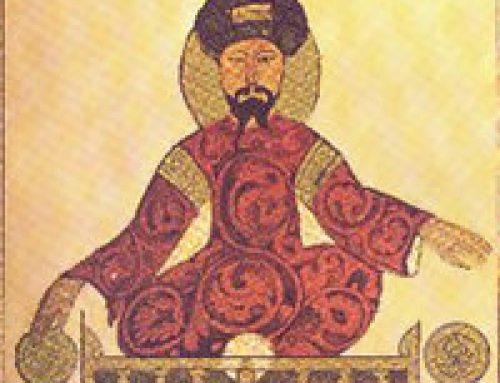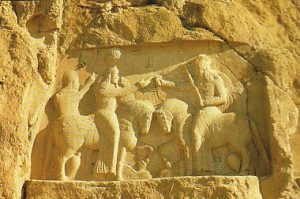
Ardashir, the first ruler of the Sassanians
Rulers of the Parthian Empire
In 211 AD, a group of Iranians called the Sassanians (the descendants of Sassan) took over control of the Parthian Empire from the Parthians. The Sassanians were proud of their Persian heritage, and they wanted to re-establish the borders of the old Iranian empire. This meant reconquering all the land to the edge of the Mediterranean Sea from the Romans (Israel, Syria, Lebanon, Jordan, Turkey), and also reconquering Egypt from the Romans.
The Sassanians were Zoroastrians
Like their Iranian ancestors, these Sassanid Persians were Zoroastrians, and they also wanted to spread the Zoroastrian faith.
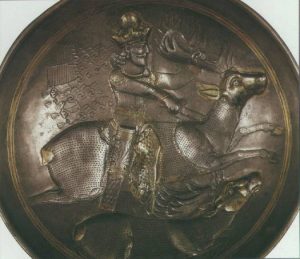
Shapur I, son of Ardashir
The leader of the Sassanians, by 227 AD the king of the Parthian Empire, was named Ardashir. (The Greeks and Romans called him Artaxerxes.) He organized a very strong and unified government. Then he took the army and invaded Roman territory in West Asia. Neither side won a clear victory, and this set the pattern for the next four hundred years. There was a lot of fighting but no real change in the borders.
Sassanians and the Silk Road
The Sassanians got very rich. They carried a lot of Silk Road trade between Central Asian kingdoms like the Rouran, the Avars, and the Sogdians, and nearby places like China, Tibet, India, Egypt, the Byzantine Empire, and East Africa. The Sassanians learned how to grow cotton from Indian farmers, and they produced cotton cloth and sold it. They also bought a lot of Indian cotton cloth and sold that too. Sassanian silversmiths made a lot of beautiful silver cups and plates to sell to China and India. They sold excellent horses, Persian carpets, glass cups, peaches, medicines, and many other things.
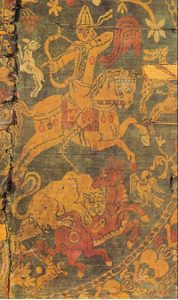
Bahram V Gor (Sassanian king 400s AD); the cloth is Sassanian silk from the 700s AD
In exchange they got gold and furs, perfume, wine, and slaves from the Roman Empire, silk and porcelain and paper from China, ivory and slaves and gold from East Africa, cinnamon and pepper and pearls and medicines and sugar and steel from India.
Sassanian law code
Like other people around the Mediterranean and West Asia at this time – and both influenced by and influencing Roman law codes like Ulpian’s Digest about 211 AD, or Justinianic Digest of 534 AD, and the Talmud’s Gemara published about the same time – the Sassanids published collections of legal rulings. The earliest are commentaries on the Zoroastrian Avesta, written no later than the 300s AD. The greatest of these Sassanian digests was the Book of a Thousand Judgments, about 620 AD.
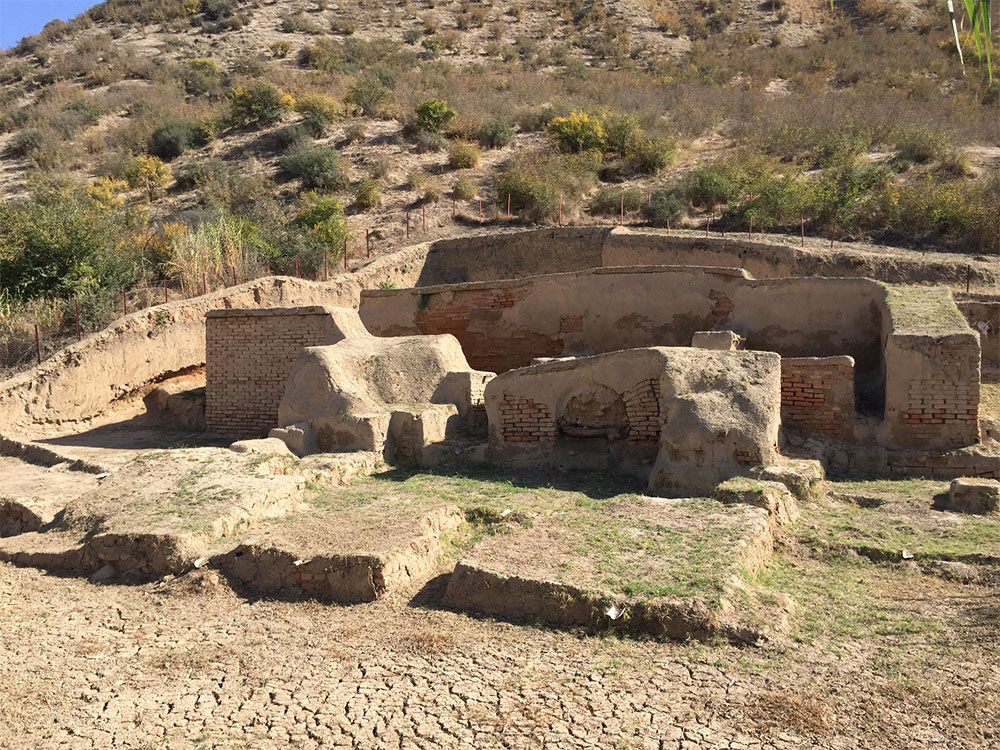
Fort of Kaser-e-Pishkamar (thanks to Stuart Denison)
During the 400s AD, Central Asian White Huns started attacking Iran from the north, just as the Huns attacked the Roman Empire at the same time. To keep them out, the Sassanians built a Great Wall, like the earlier Great Wall of China, ten meters wide and three meters high, all along their northern border – about 200 kilometers long. But the White Huns conquered eastern Iran anyway. It took the Sassanians until about 550 AD to push them out again.
Islam conquers the Sassanians
Gradually the Romans and the Sassanians both got in the habit of paying Arab mercenaries from the Arabian Peninsula to fight most of their battles for them. And in the 600s AD, those Arab mercenaries decided to fight on their own account instead. They easily conquered both the Romans and the Sassanians, and established the Islamic Empire.
Learn by doing: visit a store that sells Persian carpets
Sassanian kings and queens
Persia under the Islamic Empire
Bibliography and further reading about the Sassanians:
Ancient Persia, by Don Nardo (2003). For kids, good for reports.
Parthian Art, by Malcolm Colledge (1977). Not very easy to get anymore, but it’s the classic book for the Parthians – it has a lot more than just the art.
Ancient Persia, by Josef Wiesehofer (2001). Includes the Parthians and the Sassanians.
Sasanian Society: Warriors, Scribes, Dehqans, by A. Tafazzoli (2000). An Iranian perspective.
The Cambridge History of Iran: Volume 3, The Seleucid, Parthian and Sasanid Periods, Part 2: Seleucid Parthian, edited by E. Yarshater (reprinted 1983). Expensive but complete.
